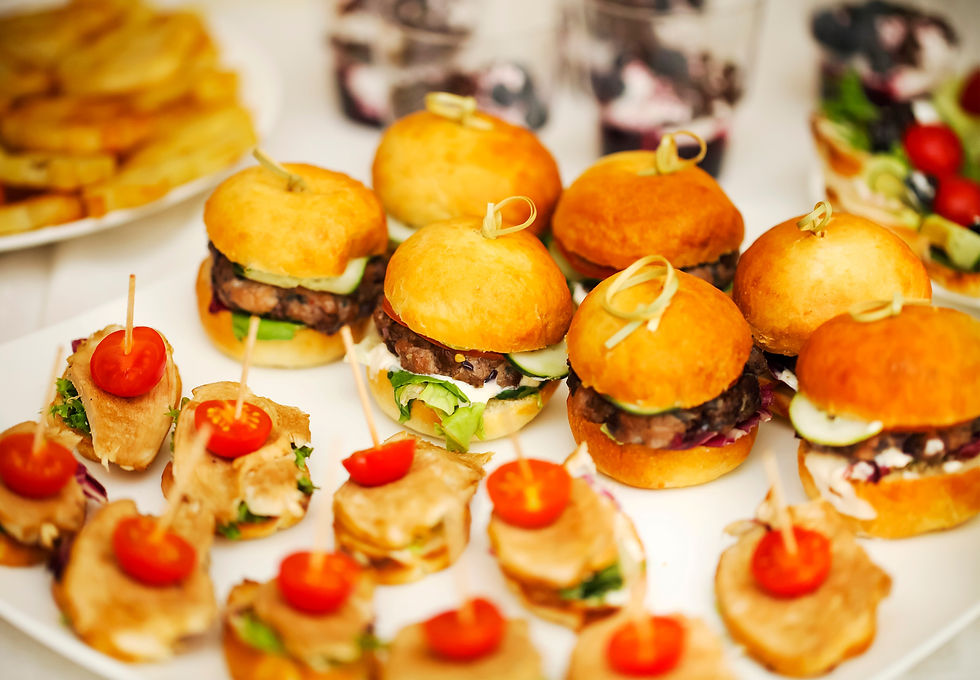20 Tips to Consider for Your Catering Menu
- Scott Stacey
- Mar 25
- 4 min read
Updated: Apr 15

Crafting a catering menu is a blend of art and science requiring a balance across the event's theme, the needs and desires of the attendees, budget, available seasonal ingredients, weather forecast, and the specific location of the event.
As a catering business based in St. Augustine. understanding all these factors plays a huge role in curating a memorable and delicious menu.
Below are 20 tips to guide you in creating catering event menus that will stand out and leave a lasting impression.
20 tips for coming up with catering event menus
Understand the event theme: the menu should be in alignment for example a beachside wedding might call for light fresh seafood dishes while a formal or corporate event may demand elegant hors doeuvres and sophisticated plated meals.
Consider seasonality of ingredients: leverage seasonal produce for better flavor and lower costs. Florida's warm climate means a menu full of fresh fruits vegetables and seafood can work well year-round.
Analyze the guest list: knowing the type of guests, whether they're foodies, families, or corporate executives, will influence the style and complexity of the menu. You can also predict preferences for types of cuisines or flavors.
Work within the budget: understand your budget before deciding on the menu focus on cost-effective yet delicious options such as incorporating more vegetables, or affordable cuts of meat while still elevating the presentation.
Offer variety for dietary restrictions. Include options for vegetarians, vegans, gluten-free, kosher, halal, and other dietary needs to ensure everyone feels included. Having clearly marked dishes makes it easier for guests to find what they can eat.
Incorporate local ingredients: St. Augustine is in Florida, so take advantage of locally grown citrus tomatoes seafood and herbs to create fresh, authentic dishes that resonate with the region.
Embrace seafood: St. Augustine is known for its seafood, so be sure to incorporate fresh local catches like shrimp oysters and fish into your menus. A seafood bar or a ceviche station could be a hit at a coastal event.
Consider the event time: a brunch menu will differ from a dinner menu. Consider lighter fare such as salads quiches and pastries for brunch, or heartier meats sides and desserts for dinner.
Be mindful of the location's kitchen capabilities: understand the limitations of the event location. If if the kitchen is tight or lacks equipment, plan a menu that can be easily transported and served with minimal preparation on-site.
Create complementary flavor profile: whether its Mediterranean, southern, or Latin-inspired, keep the flavor profile consistent. This helps create a harmonious dining experience where each dish complements the others.
Design interactive stations or buffets: an interactive station such as a taco bar, pasta station, or carving station can be a fun way to engage guests while allowing them to customize their meals according to preference.
Highlight local culture: Florida's cultural influences, including Spanish, southern, and Caribbean flavors, should shine through in your menu. Dishes such as Cuban sandwiches, conch fritters, or key lime pie are popular in this region.
Balance health and indulgence: while its important to offer indulgences like rich desserts and fried foods, be sure to balance the menu with lighter, healthier options such as salads, grilled fish, or roasted vegetables.
Climate and weather considerations: hot weather means you should avoid overly heavy or greasy dishes that could weigh people down. Consider cooler salads, fruit platters, and chilled appetizers.
Offer local sweets: desserts are always a highlight at catering events. Incorporate Florida flavors like orange sorbet, key lime pie, or coconut cake to create a most memorable sweet finish.
Adjust for formality: the formality of the event will guide the type of service you offer, whether buffet-style, plated service, or family-style dining. Ensure the menu works seamlessly with your chosen service style.
Use garnishes and creative presentation: creatively beautiful presentation can elevate even the simplest dish. Use edible flowers, garnishes from local herbs, and decorative platters that match the events theme.
Consider beverage pairings: offer beverage pairings for each course, keeping in mind local craft beers, wines from Florida vineyards, or signature cocktails. This adds another layer to the guest experience.
Plan for leftovers and sustainability: create a plan for handling leftovers, either donating them or packaging them for guests. Using sustainable packaging and reducing food waste make for smart business.
Get feedback from the client: have a thorough discussion with your caterer about what they and you envision for the menu. Personalize the menu to meet your preferences and the vibe you want to create for their event.
Crafting the perfect catering menu involves blending creativity with practicality, by taking into account the theme, budget, dietary preferences, seasonal ingredients, and location. You can curate a menu that will enhance the experience and leave guests satisfied. In St. Augustine where the local cuisine and fresh ingredients are abundant, there are endless possibilities to create a catering menu that is both delicious and memorable. By following these 20 tips you'll be well on your way to designing a catering menu that is perfectly tailored to any event



Commentaires